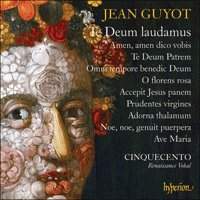Texte paru dans: / Appeared in: |
|
|
Outil de traduction ~ (Très approximatif) |
|
|
Reviewer: J.
F. Weber
This superb Renaissance vocal
ensemble has focused its attention mostly on mid-16th-century sacred music
of mostly obscure composers. In a departure (Fanfare 38:3), it recorded a
disc of secular music of the period, including that of Jean Guyot de
Châtelet (c. 1520–1588), whose only previous recording was on a Belgian CD
(21:3). Now it has turned to his sacred music for his first full CD. Guyot
was born in Châtelet (in the principality of Liège), but the date is only
guesswork, based on his entrance to the University of Louvain in 1534. The
date of his priestly ordination is unknown, but he became a canon at St.
Paul’s, one of the seven collegiate churches of Liège, in 1546. He published
both motets and chansons for five voices in the next few years, and in 1558
became director of music at the cathedral of St. Lambert in Liège. In 1563
he went to the imperial court in Vienna, where he composed motets for six to
12 voices, but the succession of Maximilian II the next year left him
unemployed, so he returned to Liège. Only the Te Deum laudamus that
concludes this program (by far the longest work here), the hymn of
thanksgiving used on every important occasion, is known in a manuscript from
this final period of 24 years. His name appears in various accounts but his
activity in this last time of his life is not recorded. His total surviving output includes a Mass, 26 motets, and 16 chansons. The music recorded here, a representative sample of the sacred music, includes three works for six voices: two from the Vienna period and one, Adorna thalamum, from a manuscript dated 1565. Cinquecento sings them with such conviction that Guyot’s place in his own time, “a leading light in Liège,” we are told, is easily understood. That city, remember, was an ecclesiastical principality for 800 years, the bishop acting as secular ruler of a territory sprawling beyond the present boundaries of eastern Belgium. Its seven collegiate churches (where, just as in the cathedral, a group of canons sang the Divine Office daily) must have exceeded the number in most other European cities. One wonders how beloved the prince-bishop was for his St. Lambert cathedral to be razed to the ground after France annexed the territory in 1795, the site barren to this day. (Guyot’s St. Paul became the cathedral in 1802.) Recall that Du Fay’s Cambrai cathedral and Ockeghem’s basilica of St. Martin in Tours suffered the same fate. There is
not one weak work in this collection. Jean Guyot is a neglected master of
the mid-16th century; his reputation is bound to grow with this disc as
evidence. Be sure to hear it. | |
|
|
|
|
Cliquez l'un ou l'autre
bouton pour découvrir bien d'autres critiques de CD |
|




